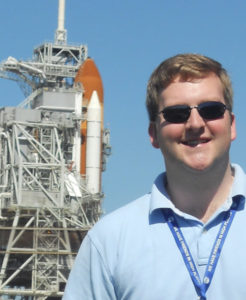 My expedition into science and engineering began at a young age, with model rocketry. Growing up near Johnson Space Center in Houston, I spent countless hours daydreaming about, designing, and building model rockets. Many of my creations would ultimately be lost to wind, or fire, or the branches of nefarious trees, but my occasional successes made it all worthwhile. By the time I was 9 or 10 years old, I’d won my first science fair – with a rocket carrying a cargo of unsuspecting crickets – and in spite of all the rockets that didn’t make it home, I considered myself ready to charge off into the wild blue yonder and become a rocket scientist. This narrative – of an exciting success compelling me to look past my failures and continue dreaming of greatness – has been a common motif in my life.
My expedition into science and engineering began at a young age, with model rocketry. Growing up near Johnson Space Center in Houston, I spent countless hours daydreaming about, designing, and building model rockets. Many of my creations would ultimately be lost to wind, or fire, or the branches of nefarious trees, but my occasional successes made it all worthwhile. By the time I was 9 or 10 years old, I’d won my first science fair – with a rocket carrying a cargo of unsuspecting crickets – and in spite of all the rockets that didn’t make it home, I considered myself ready to charge off into the wild blue yonder and become a rocket scientist. This narrative – of an exciting success compelling me to look past my failures and continue dreaming of greatness – has been a common motif in my life.
As my knowledge and interests have grown and matured alongside me, I have been able to leverage my passion into success in a number of endeavors. My work on model rockets, and later, computers, helped me get into Vanderbilt University, where I was able to do research on a number of different topics in mechanical and aerospace engineering. Those same credentials propelled me into a leadership role in Vanderbilt’s nascent Aerospace Club. With funding secured from NASA and other organizations, we built airplanes, rockets, and other devices, and traveled all over the country to present our work and participate in design competitions. From Vanderbilt, it was on to Georgia Tech, where my undergraduate work and other experiences had earned me a prized position in graduate school to study Aerospace Engineering. At Tech I spent most of my time working on computer-based analysis of aircraft performance – focusing on environmentally-friendly aviation – and I quickly found myself growing restless. After two years of hard work getting my Master’s from Tech, I absconded to Australia on a fellowship from the National Science Foundation, to work on a more applied aspect of the same project – flight test!
The problems that interest me have always been the ones with the most tangible outcomes, and which are beneficial to society at large. Any time I can get my hands dirty or turn a wrench, that’s an added bonus. Most of my work, including what I did in Australia, and will be doing in Belgium, is on an aircraft called the blended wing-body, which is conceived as an eco-friendly replacement for civil airliners. At Georgia Tech I worked on some computational optimization algorithms for this design. In Australia I did flight-test-based stability and control studies. In Belgium, we’re taking it back to the drawing board to examine some new proposed engine inlets. I’ll be working in a special three-institute collaboration, interacting with researchers from all over the globe, and taking advantage of world-class wind tunnels, and computational resources, to see if this new design is all that it’s cracked up to be. I can’t wait to see how it goes.
When I arrive in Brussels, I’ll be diving head-first into a new kind of project, in a new place. I do not know what my findings will be, or which aspects of the project will go according to the plan, and which will not. I don’t know exactly what I will do when I return to America, or what the future holds for me. What I do know is that, a year from now, I will look back upon my time in Belgium as a highlight of my career, and a critical developmental stage in my life. And so, as I embark on this great journey, I look forward with cautious optimism, and a sense of adventure, and mystery. I hope that I have the courage, and fortitude, and good sense to make it all worthwhile.